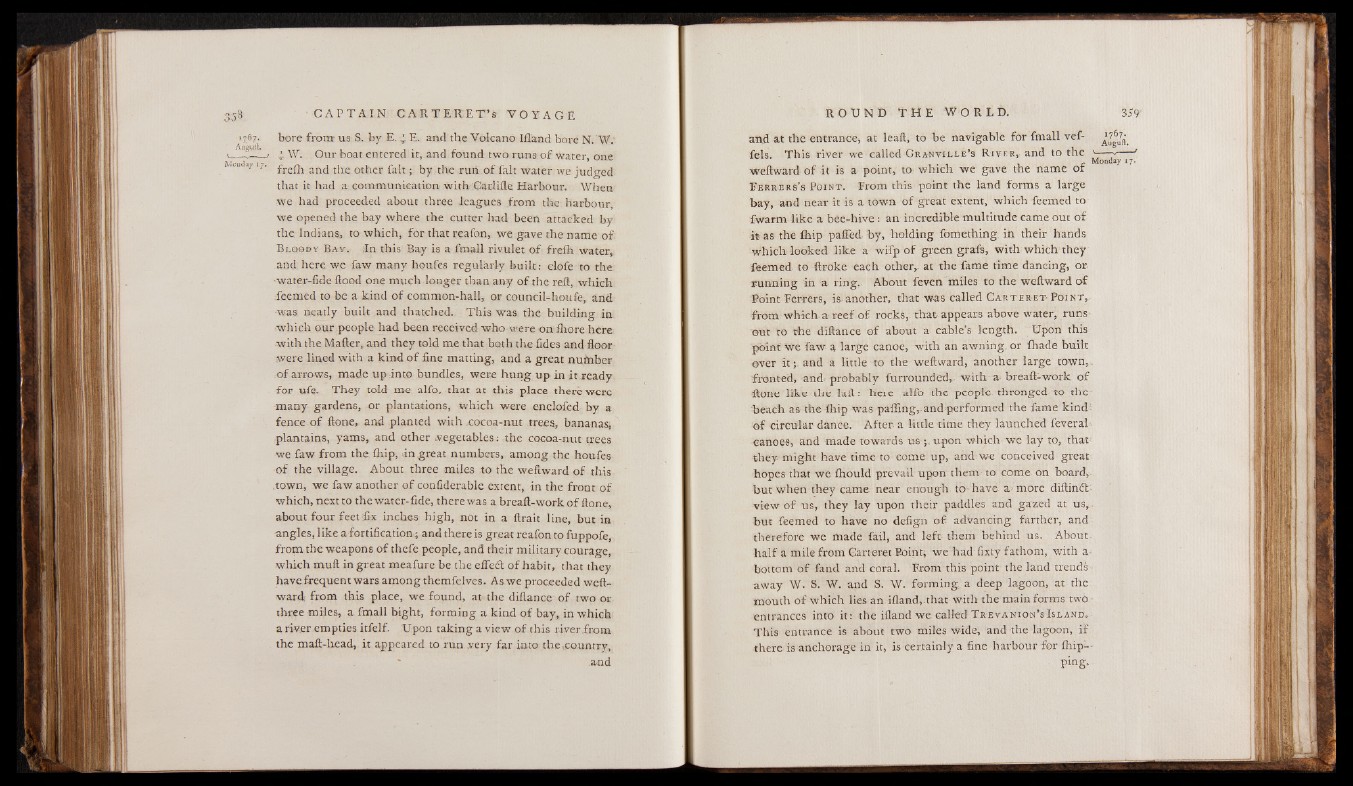
1767. bore from- us S. by E. $ E. and the Volcano Iftand bore N. W . '
Augiilt. '
_ 1 i ,W. Our boat entered it, and found two runs o f water, one
Monday 17. and other fa it ; by the run o f fait water we judged
that it had a communication with Carlifle Harbour. When
we had proceeded about three leagues from the harbour,
we opened the bay where the cutter had been attacked by
the Indians, to which, for that reafon, we gave the name of
B l o o o y B a y . in this Bay is a fmall rivulet o f frefh water,
and here we faw many houfes regularly built: clofe to the
water-fide flood one much longer than any of the reft, which
Teemed to be a kind of common-hall, or council-houfe, and
-was neatly built and thatched. This was the building in
which our people had been received who were on fhore here
with the Matter, and they told me that both the fides and floor
were lined with a kind o f fine matting, and a gFeat nufnber
o f arrows, made up into bundles, were hung up in it ,ready
for ufe. They told me alfo, that at this place there were
many gardens, or plantations, which were enclofed by a
fence o f ftone, and planted with xocoa-nut trees, bananas,
plantains, yams, and other vegetables: the cocoa-nut trees
we faw from the £hip, in great numbers, among the houfes
o f the village. About three miles to the weftward of this
town, we faw another of confiderable extent, in the front of
which, next to the water-fide, there was a breaft-work of ftone,
about four feet fix inches high, not in a ftrait line, but in
angles, like a fortification; and there is great reafon to fuppofe,
from the weapons o f thefe people, and their military courage,
which muft in great meafure be the effedt o f habit, that they
have frequent wars among themfelves. As we proceeded weft-
ward from this place, we found, at the diftance o f two or
three miles, a fmall bight, forming a kind o f bay, in which
a river empties itfelf. Upon taking a view o f this river from
the maft-head, it appeared to run very far into the country,
and
and at the entrance, at leaft, to be navigable for fmall vef- ||||||
fels. This river we called G r a n v i l l e ’s R iv e r , and to the 5— -— , . , , c Monday i;
weftward of it is a point, to which we gave the name or
E e k r er s ’s Po in t . From this point the land forms a large
bay, and near it is a town of great extent, which feemed to
fwarm like a bee-hive : an incredible multitude came out of
it. as the fhip pafled. by, holding fomething. in their hands
which looked like a wifp of green grafs, with which they
feemed to ftroke each other,- at the fame time dancing, or
running in a ring. About feven'miles to the weftward of
Point Ferrers, is>another, that was called C a r t e r e t -Po in t ,
from which a reef of rocks, that-appears above water, runs
out to the diftance ©f about a cable’s length. Upon this
point we faw a large canoe, with an awning, or lhade built
over i t a n d a little to the weftward, another large town,
fronted, and probably furrounded, with a- breaft-work of
ftone like the laft: here alfo the people thronged to the
beach as the Ihip was palling,, and performed the fame kind-
o f circular dance. After a little time they launched feveral
canoed, and made towards us upon which we lay to, that’
they might have time to come up, and we conceived great
hopes that we fhould prevail upon them to come on board,
but when they came near enough to- have a more diftindf
view o f us, they lay upon their paddles and gazed at us,
but feemed to have no defign o f advancing farther, and
therefore we made fail, and left them behind us. About,
h a lf a mile from Carteret Point; we had fixty fathom, with a-
bottom of fand and coral. From this point the land trends-
away W. S. W. and S. W. forming a deep lagoon, at the
mouth of which lies an iftand,that with the main forms two
entrances into it: the ifland we called T r e v a n io n ’s Is l an d. •
This entrance is about two miles wide, and the lagoon, i f
there is anchorage in it, is certainly a fine harbour for fhipping.